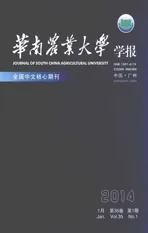A new ly recorded species of the genus Melanthrips Haliday(Thysanoptera:M elanthripidae)in China
2014-03-05YANGShulanMAJIDMicrabbalouTONGXiaoli
YANG Shulan,MAJID Micrab-balou,TONG Xiaoli
(College of Natural Resources and Environment,South China Agricultural University,Guangzhou 510642,China)
Melanthripidae is one of the eight families recognized in the suborder Terebrantia.Members of this family feed on flowers,which is also the place for their breeding[1].The members of this family are identified by having a pair of lobeswith an associated two pairs of setae on the posteriormargin of the seventh sternite;a well developed pair of trichobothrium on the tergite X;transverse sensoria on the antennal segments,and a fully devleoped tentorium in the head.
This family includes 65 species in four genera,of which Melanthrips with 36 species is the largest genus[2].In China,the genus Melanthrips was recorded with two species:M.fuscus and M.pallidior[3];and there is the third species:M.knechteli,which is recorded for the first time.Specimens for study weremounted with Canada balsam.Illustrationsweremade using a camera lucida.The specimens are now preserved in the insectmuseum of department of entomology,South China Agricultural University,Guangzhou(SCAU).
Genus Melanthrips Haliday
Melanthrips Haliday,1836:450[4].
Generic diagnosis. The body generally dark brown,brownish in some species,antennal segmentⅢis yellowish or slightly lighter than other segments;fore wings grey or brownish but pale atbase.Antennal distal segments fully distinct from each other and segmentsⅡ-Ⅶ with rows ofmicrotrichia,sensoria onⅢ andⅣin the form of an oblique line or ring near the apex of the segments and partly or entirely encircling them.Head prolonged between the base of antennae and maxillary palps 3-segmengted.Pronotum has 4-7 pairs of posteromarginal setae,rarely 3 pairs in certain species,otherswith 6-7 pairs;both pronotum and pterothorax covered with microtrichia;mesosternum with spinula.Fore wings broad with 2 longitudinal and 5 cross-veins.Fore tibia with a robust spine at the apex.Abdominal tergite X with paired trichobothria is fully developed;sternites with discal setae;sternitesⅦwith a pair of posteromarginal lobes.
Key to Chinese species of Melanthrips
1.Fore wings with cilia between the costal setae much shorter than these setae M.fuscus(Sulzer)…………-Fore wingswithout cilia between the costal setae 2…………………………………………………

a:abdominal sternitesⅡ -V(♂),b:meso& metanotum,c:head(♂),d:fore wings,e:antennal segmentsⅢ & Ⅳ (♀),f:antenna(♀)Fig.1 Melanthrips knechteli Priesner,1936
2.Sense lines of the antennal segmentsⅢandⅣof the ventral widely across the dorsal side;sensory areas broad,and much widened at their tips(Fig.1a).SterniteⅢwith only one discal setae M.knechteli Priesner……………………………
Sensory areas on antennal segmentsⅢ and Ⅳ short,and exactly circumpolar,semicircularly following the apicalmargin of the segments.Abdominal sterniteⅢwith 2-3 andⅣwith 1-2 pairs of discal setae M.pallidior Priesner……………………………
Melanthrips fuscus(Sulzer)
Thrips fuscus Sulzer,1776:113;in Priesner,1936:32.
This species was identified based on the descriptions by Priesner(1936)[5]and the key provided by zur Strassen(2003)[6].
M aterial exam ined.CHINA:Zhejiang Province:1♀,Huajiachi Campus at Zhejiang University,Hangzhou,from flowers,9.iv.2010,coll.M.Mirabbalou.
Diagnosis.Body,legs and antennae dark brown,fore tarsiand antennal segmentⅢpaler;forewing shaded brown;head with 3 pairs of prominent postocular setae,and one pair of long ocellar setae;antennae 9-segmented,segmentsⅢ andⅣ with oblique sensorium at apex;pronotum with 6-7 pairs of posteromarginal setae;tarsi 2-segmented,fore tibia with stout dagger shaped seta at inner apex;metanotalmedian setae small and arising near posteriormargin;fore wings with cilia between the costal setaemuch shorter than these setae;abdominal tergite X with a pair of trichobothria;sterniteⅡ with 2 pairs ofmarginal setae,and no discal setae,Ⅲ–V(+VI)with a few scattered discal setae;Ⅶwith 3 pairs of marginal setae,also 2 pairs of smaller setae at base of paired marginal lobes.
Male similar to female but smaller;abdominal sternitesⅢ-Ⅵ with 2-3,0-2,0-1 and 0 discal setae,respectively.
Distribution.China:Jiangsu,Zhejiang.Iran,Europe,North Africa,Cyprus,Palestine,Egypt.
Melanthrips knechteli Priesner(NEW RECORD)(Fig.1)
Melanthrips knechteli Priesner,1936:40.
This species was identified based on the original description by Priesner(1936)[5].
M aterial exam ined.China:Jiangsu Province;3♀♀,Nanjing,from wheat and Chenopodiaceae,11.v.1985,18.v.1985,coll.Ge Zhengyan;Zhejiang Province;1♂,Huajiachi Campus at Zhejiang University,Hangzhou,from grass,9.iv.2010,coll.M.Mirab-balou;3♂♂,Jiuxi,Hangzhou,from tea,27.Ⅲ.2010,coll.M.Mirab-balou.
Diagnosis.Body brownish gray;basal half of antennal segmentⅢ and apex ofⅡ light gray;fore wings smoky with slightly paler at base,fore tibiae yellowish apically;head with 3 pairs of ocellar setae,pairⅢ longest;antennae 9-segmented,sensory areas on antennal segmentsⅢandⅣobliquely situated;pronotum with 4-5 pairs of posteromarginal setae;mesonotum with longitudinal striate,in posterior halfwith rows ofmicrotrichia;metanotalmedian setae small and arising near posteriormargin;fore wings without cilia between the costal setae;abdominal tergite X with a pair of trichobothria;abdominal sterniteⅡwith 2 pairs ofmarginal setae;sterniteⅢ with only one discal setae;Ⅶ with 3 pairs ofmarginal setae,also 2 pairs of smaller setae at the base of paired marginal lobes.
Male similar to female but smaller,narrower and lighter than female.
Distribution.China:Zhejiang,Jiangsu.Iran,Turkey,Bulgaria,Romania,Albania,Czech Republic and Spain.
Melanthrips pallidior Priesner
Melanthrips pallidior Priesner,1919:119[7].
This species was identified based on the descriptions by Priesner(1936)[5]and the key provided by zur Strassen(2003)[6].
M aterial exam ined.China:Zhejiang province;1♀,Huajiachi Campus at Zhejiang University,Hangzhou,from flowers,9.iv.2010,coll.M.Mirab-balou.
Diagnosis.The body is brownish yellow or brownish black;antennal segmentⅢis paler than others;fore wings somewhat paler at the base but sometimes only the extreme base of costa lighter;fore tibiae rather dark;head with 3 pairs of ocellar setae,pairⅢ being the longest;antennae 9-segmented,sensory areas of antennal segmentsⅢ andⅣ peculiar,always exactly circumpolar,and short;pronotum with 4-5 pairs of posteromarginal setae;mesonotum with longitudian striate,in posterior half with rows of microtrichia;metanotal median setae small and arising near posterior margin;fore wings without cilia between the costal setae;abdominal tergite X with a pair of trichobothria;abdominal sterniteⅢ with 2-3 pairs of discal setae,andⅣwith 1-2 pairs;Ⅶ with 3 pairs ofmarginal setae,also 2 pairs of smaller setae at the base of paired marginal lobes.
Male smaller,sternitesⅢ,Ⅳ and V with 1-2,1 and 0-1 pairs of discal setae.
Distribution. China:Jiangsu, Zhejiang, Sichuan[8-9].Iran,Russia,Turkey,Palestine,Cyprus,Europe,North Africa.
Acknow ledgem ents:
We would like to express our gratitude to Prof.Zhang Weiqiu for his useful advices!
[1]DE BORBON,CM.A redefinition of Dorythrips(Thysanoptera:Melanthripidae)with a description of a new species from Argentina[J].Zootaxa,2009,2121:17-26.
[2]MOUND L A.Thysanoptera(Thrips)of the World-a checklist[EB/OL].Australia:CSIRO,2005 [2012-11-18]. http:∥ www.ento. csiro.au/thysanoptera/worldthrips.html.
[3]MIRAB-BALOU M,TONG Xiaoli,FENG Jinian,et al.Thrips(Insecta:Thysanoptera)of China[J].Check List,2011,7(6):720-744.
[4]HALIDAY A H.The entomological magazine[M].London:Nabu Press,1836:439-451.
[5]PRIESNER H.A preliminary review of the non-fossil species of the genus Melanthrips Hal[J].Bulletin de la SociétéRoyale Entomologique d'Egypte,1936,20:29-54.
[6]ZUR STRASSEN R.Die terebranten thysanopteren europas und des mittelmeer-gebietes,series:Die tienwelt dentschland 74[M].Jena:Verlag Goevke& Evers,2003:1-271.
[7]PRIESNER H.Zur thysanopteren-fauna albaniens sitzungsberichte der kaiserlichen akademie der wissenschaften I:128 band[M].Wien:Aus der Staatsdruck erei,1919:115-144.
[8]HAN Yunfa.Economic insect fauna of China:Fasc Vol.55:Thysanoptera[M].Beijing:Science Press,1997:513.
[9]YANG Xingke,WANG Shufang,ZHENG Leyi,et al.Insects of the three gorge reservoir area of Yangtze River:Vol.1[C]∥HAN Yunfa.Thysanoptera:Aeolothripidae,Thripidae and Phlaeothripidae.Chongqing:Chongqing Publishing House,1997:531-571.
【责任编辑霍 欢】
